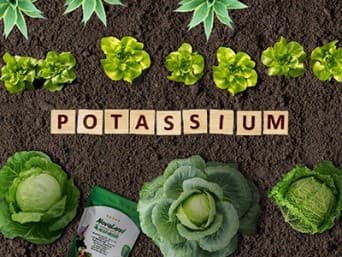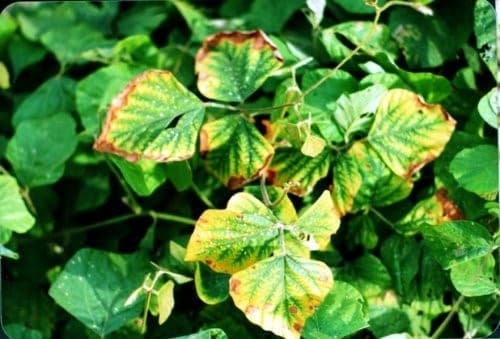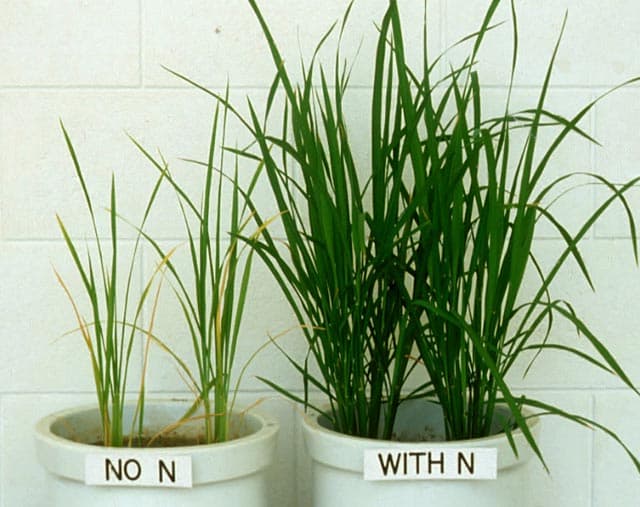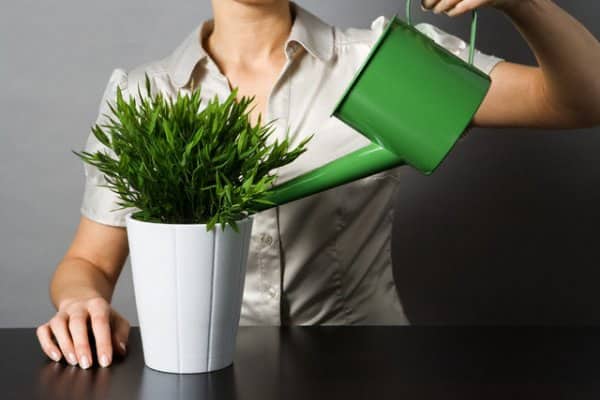Potassium deficiency
 Potassium is one of the most important element for plant nutrition. Compared with other metals, the amount of potassium in the plant is quite large, especially in a stem and leaves. Most of the potassium cations are contained in the cell sap maintaining the physiological concentration of the solution, the physiological state of the cell colloids. Aided by potassium, the processes of storing nutrients, their synthesis and transport are carried out. In young and rich with protoplasm cells, a large part of the potassium is in the adsorbed state. Another basic function of potassium is also a catalysis: it promotes the synthesis of high-molecular substances (such carbohydrates, starch, fats, proteins, etc.) and simple compounds. In addition, potassium increases the plant's resistance to stresses such as extreme temperatures, illnesses and others by increasing the turgor and reduction of water evaporation.
Potassium is one of the most important element for plant nutrition. Compared with other metals, the amount of potassium in the plant is quite large, especially in a stem and leaves. Most of the potassium cations are contained in the cell sap maintaining the physiological concentration of the solution, the physiological state of the cell colloids. Aided by potassium, the processes of storing nutrients, their synthesis and transport are carried out. In young and rich with protoplasm cells, a large part of the potassium is in the adsorbed state. Another basic function of potassium is also a catalysis: it promotes the synthesis of high-molecular substances (such carbohydrates, starch, fats, proteins, etc.) and simple compounds. In addition, potassium increases the plant's resistance to stresses such as extreme temperatures, illnesses and others by increasing the turgor and reduction of water evaporation.
In comparison with phosphorus, the level of assimilation of potassium from fertilizers is at a rather high level. However, different plants take a lot of potassium from the soil. Vegetables absorb most of potassium: they can carry up to 400-500 kg of potassium with a crop. In addition, the high migration capacity of potassium ions is a significant problem of the using of potassium fertilizers that can result in a deficiency of this element in light soils (sandy, sandy-loamy) but with a high amount of precipitation the efficiency of potassium fertilizers also decreases. To avoid the lack of potassium wood ash is the easiest fertilizer. First big problem is a small amount of ash for processing large areas. To process 1 ha of soil you need more than 1 ton of ash. It is not an easy task to get such a large amount of it. Therefore, to eliminate the deficit of potassium, it is best to use ready-made fertilizers, such as NovaLand Seaweed Organic Extract. Organic fertilizers contain not only a lot of potassium, but also an organic substance, which assists to assimilate of potassium and accumulate it by the soil.
Now you know how potassium important for plants is and how to deal with it deficiency. However, how do you know that the plants do not have enough?
 Diagnostic of a lack of potassium is considered quite a difficult exercise, because it may be a bit like both a lack of nitrogen and a lack of irrigation water for plants. If the excess of potassium is simple - stems and leaves of plants are strongly stretched without gaining mass, then with a lack of potassium it appear several symptoms.
Diagnostic of a lack of potassium is considered quite a difficult exercise, because it may be a bit like both a lack of nitrogen and a lack of irrigation water for plants. If the excess of potassium is simple - stems and leaves of plants are strongly stretched without gaining mass, then with a lack of potassium it appear several symptoms.
It is important to understand that in a case of a lack of nitrogen mostly young leaves and shoots suffer, the lack of potassium is manifested mainly on old leaves and shoots. Also, lack of potassium and insufficient watering, they have the same symptom: plants loss of turgor by leaves and become a sluggish.
The main sign of potassium, among others, is the marginal burn: the edges of the leaves of the plants become yellow. Yellowing eventually spreads deep into the leaf plate, and the yellowed parts become dry and then die. Potassium deficiency can also be accompanied by other symptoms, such as the formation of yellow and brown points on the leaves, deformations of the leaf blade.
If you do not respond appropriately and do not fill the lack of potassium with fertilizers, such as Novaland Seaweed Organic Extract, growth will slow down considerably; plants will less tolerate stress and environmental conditions. In addition, during the flowering period you can observe leaf fall and fruits will have a low masses and small sizes. Formed new shoots will be deformed. Potassium deficiency is one of the main causes of low yields in both agricultural production and plant growing by farmers.
In addition, without the use of potassium fertilizers, such as Novaland Seaweed Organic Extract, the resistance of plants to fungal diseases decreases, which will force you to use chemical compounds, which definitely will not make your products healthy and useful.
However, doses of potassium fertilizers should be carefully calculated, because excessive potassium affects the intake of calcium and magnesium, so use fertilizers wisely.

 In previous article we told about lack of nitrogen in plants, how dangerous it is and how to deal with it or prevent it with the help of Novaland.
In previous article we told about lack of nitrogen in plants, how dangerous it is and how to deal with it or prevent it with the help of Novaland. The first symptoms of phosphorus deficiency are dull blue-green spots on the surface of the leaves. In a case of strong lack of phosphorus it forms red-violet spots on the leaves of plants. The tips of leaves with a strong phosphorus deficiency look burnt with signs of necrosis. If you do not take the necessary measures to eliminate phosphorus starvation, then plants can die.
The first symptoms of phosphorus deficiency are dull blue-green spots on the surface of the leaves. In a case of strong lack of phosphorus it forms red-violet spots on the leaves of plants. The tips of leaves with a strong phosphorus deficiency look burnt with signs of necrosis. If you do not take the necessary measures to eliminate phosphorus starvation, then plants can die. Chlorosis, yellow leafs, growth slowdown, thin shoots, little leafs and low yield. If you see it when your plants growth we guess your plants lacks nitrogen. To prevent the future problems you need to use fertilizers such as Novaland Seaweed.
Chlorosis, yellow leafs, growth slowdown, thin shoots, little leafs and low yield. If you see it when your plants growth we guess your plants lacks nitrogen. To prevent the future problems you need to use fertilizers such as Novaland Seaweed.
 Food is a basic need of a human, without which he cannot begin to satisfy the others. By Maslow’s hierarchy of needs, without food, a person cannot feel them safe, enjoy the culture, study new, or express himself in the struggle for a common cause. In addition, this is true, because in the absence of a full-fledged, healthy and high-quality nutrition, not only the motivation, but also the health status of a person, his health and activity, is reduced. Nano-fertilizers are necessary for the production of nutritious and biologically pure products. According to IGC forecasts, made in January, grain consumption in 2018 will exceed production by 4 million tons. Imagine yourselves that 4 million tons of grain. A city with population of 1 million people consume an average 3000-4000 tons of provision per day.
Food is a basic need of a human, without which he cannot begin to satisfy the others. By Maslow’s hierarchy of needs, without food, a person cannot feel them safe, enjoy the culture, study new, or express himself in the struggle for a common cause. In addition, this is true, because in the absence of a full-fledged, healthy and high-quality nutrition, not only the motivation, but also the health status of a person, his health and activity, is reduced. Nano-fertilizers are necessary for the production of nutritious and biologically pure products. According to IGC forecasts, made in January, grain consumption in 2018 will exceed production by 4 million tons. Imagine yourselves that 4 million tons of grain. A city with population of 1 million people consume an average 3000-4000 tons of provision per day.